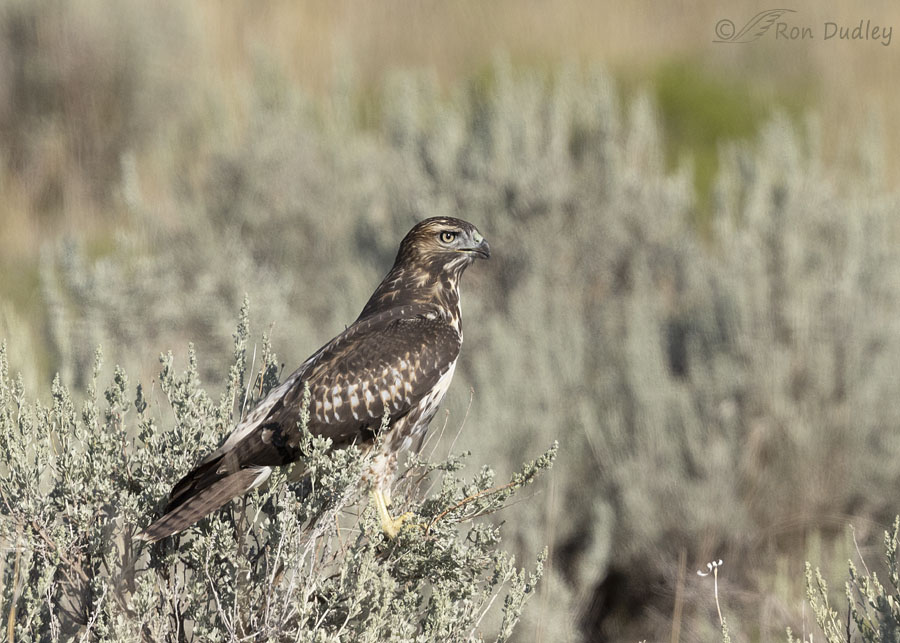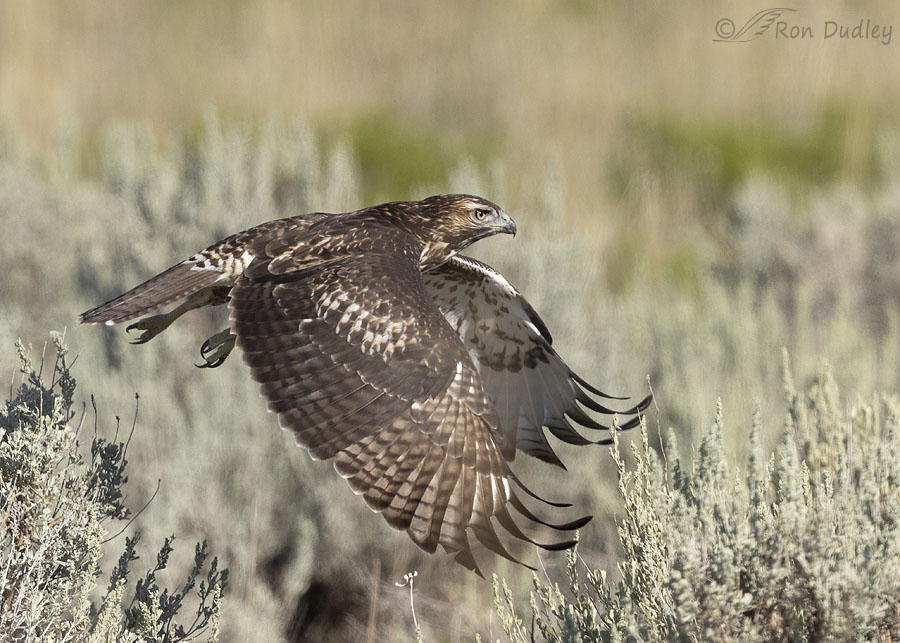For an unusual reason.

1/6400, f/6.3, ISO 800, Canon R5, Canon EF500mm f/4L IS II USM + 1.4 tc, not baited, set up or called in
I rarely see Red-tailed Hawks perched on sagebrush but two days ago this juvenile and ‘his’ sibling were both perched on sagebrush when I found them. The other bird was further away and facing away from me so I focused on this one and, like I always do, hoped for takeoff and flight shots.
I didn’t have to wait long.

1/6400, f/6.3, ISO 800, Canon R5, Canon EF500mm f/4L IS II USM + 1.4 tc, not baited, set up or called in
I was a little late pulling the trigger when he took off so I didn’t catch him with his wings up at the launch. I got 21 shots of him in flight (some of them were soft but I didn’t clip any wings) but when I looked at my photos on my camera screen I instantly knew this one would be my favorite, by far. One thing about the photo jumped out at me in a positive way. Can you guess what it was?
It was his curled and well-separated primaries on both wings. I don’t believe I’ve ever taken a photo of a raptor in flight that had this much curling, of this many primaries (all ten of them), with this much separation – especially when they’re all sharp. I just happened to time the shot right and be at the best shooting angle to the bird so that one wing didn’t hide important parts of the other. I got several other photos of him that had some curling and/or some separation but none of them were like this one.
Curling and separation of primaries in my flight shots have always appealed to me and I’m probably a little weird about that.
But we like what we like.
Ron


It is neat to see how those wing and feathers work. The curling feathers is a great shot. I bet it will lift Laura’s spirits today!
I hope she sees it, April. If anyone deserves a lift, it’s Laura.
Add me to the weirderoonies who not only really, really liked this shot but knew why you did.
I’m becoming too damn predictable, EC!
What a gorgeous guy (or girl)! Like s/he’s advancing on someone or something and saying “Come to me” with those curled fingertips! I do prefer this display to the one you posted a few weeks ago that looked so odd, with the primaries dangling down like dripping paint (but also very clearly separated). Though it was intriguing, as well.
Thanks, Chris. I think I prefer this “display” over that of any other similar photo I’ve ever taken.
Guessed it first thing. That curl, and on both wings, is stunning! A tiny smidgen of luck will often come to those who are prepared and persistent as you are.
“Guessed it first thing.”
Thanks, Granny Pat. I suppose it was a pretty easy question, especially with this photo.
Great shot. It helps illustrate how individual feathers play a role in gaining lift as well as the wing in total. As to Christine’s question of this being from muscular control that was asked, the answer is no. There are tiny muscles associated with the base of each feather. These hold it in place and allow movements of individual feathers, such as when you see a bird raising its feathers away from the body. But those muscles cannot produce a change of shape of a feather such as you see here. Pushing against the air and lift created by the wing motion is responssible for this curling. As this clearly shows, when the wing moves forward during takeoff, the tips of the feathers individually create lift. This is most apparent at takeoff but you may see it in flight at times. Think of a vultures separated feathers and how they sometimes curl during flight.
Thanks for the explanation, Dan.
I’ve always thought that the asymmetrical shape of primaries, with the vane on one side of the rachis (quill) wider than it is on the other side, also helps to explain how the feathers twist and separate under air pressure. More surface area = more resistance.
Correct. You can demonstrate that if you find a primary (of any bird) loose on the ground. Pick it up, hold the base and move it up and down. You will see that it rotated in your hand. In the bird’s wing, on the downstroke, the primaries overlap (except in takeoff as you photo shows) and form the wingfoil shape of the wing that gives lift. On the upstroke, the feather are rotated, creating slots for the air to pass through and making it easier to lift the wing. Birds are amazing.
Thanks for these great explanations! Wonderful to see it in the photo and have it explained as well.
Ron,
I’ve been following your blog for a while and have learned a lot from your photos and commentary, including the beautiful photo today.
Not to detract from your masterful capture of the red tail, but I’m wondering whether the appearance of the primaries is being accentuated by a mild degree of electronic shutter distortion. As you know, this can occur when using a fast shutter speed with an electronic shutter while photographing a rapidly moving subject, as noted at https://www.eos-magazine.com/articles/camera-feature/electronic-shutters.html An example in a flicker’s primaries is seen at https://www.audubon.org/news/the-2022-audubon-photography-awards-top-100 if you scroll down to #12.
I’ll be interested in your thoughts, if you have time. I also shoot with a Canon R5 and I love it.
Best wishes,
Russ Smith
Russ, interesting question but I wasn’t using the electronic shutter. I never do. I don’t like it.
Guessed it!!! Have looked at quite a few of your raptor shots I really like the curl as well.
I really like the curl as well.
Thanks, Kathleen.
I was instantly drawn to the curl. Fascinating!
Me too. Thanks, Arwen.
Outstanding in all respects.
Favorite bird shown in flight and in stunning detail. What’s not to like?
Yes, you are weird for liking the display of those distinctly separated primaries. So are we all.
Ha, it’s not the only way I’m weird Wally. I yam what I yam…
I cannot improve on the other wonderful comments here. The photo of the juvie RTH taking off is perfection. The flexibility of those wing tips is essential to their resilience. Amazing capture, Ron.
Thanks very much, Melania.
Excellent take off shot. I did not correctly guess why the shot especially appealed to you, but should have. When the primaries show like that they do make the photo more appealing.
Thanks, Everett.
All of your posse, including me, spotted those wondrously curled primaries
right off the bat ! I guess because it’s a totally unusual capture, and
such a graceful accent, combined with the power one expects from this
magnificent raptor……..
Well said, Kris – especially the last part.
Somehow it doesn’t seem possible that the fan of both wings could mirror each other so perfectly. But there it is. If you had pressed the exposure button any quicker you might not have captured this extraordinary moment. Timing is everything, at least in this case.
We don’t have sagebrush here but it still seems a curious parking spot. Two birds in the bush is worth….it.
“Timing is everything, at least in this case.”
Lyle, in bird photography it is in many cases, if not most.
Red-tails usually prefer higher perches than sagebrush. And more stable ones. I think those young birds are still trying to figure out what works best and what doesn’t.
Beautiful! The curled primaries caught my attention right off the bat! For being so brittle in some ways those feathers sure can flex at times!
For being so brittle in some ways those feathers sure can flex at times!  Beautiful bird………
Beautiful bird………
Impressive thunder storm the past few hours! MUCH more lightening(both cloud to cloud and cloud to ground) then we generally get with them as well as going on longer than usual. Some rain tho most S of us. That may be OK if it feeds Belt Creek……
Thank you, Judy.
You need some water in that creek! And so do the birds and critters. I hope you’re not hauling water again…
Not having to haul yet but getting close. Yes, the critters DO need the water as much as we do. Muley mom and twins down on the creek this morning getting a drink and looking for “green”. No Great Blue Herons fishing the puddles yet which is good.
That is a gem of a photo.
Those curves in the primaries were the first thing that caught my eye. Then what you see next is how all the wing feathers look so fresh and near perfectly defined. There is so much to this one.
The only apparent imperfection is the one feather on the right wing that has a couple separations in the feather. It reminded me of the artists and craftsmen of some cultures (like Navajo and Islamic rug weavers) who would deliberately introduce flaws into their work to remind themselves that such things are an integral part of all things in this world. It does not diminish a thing. Which reminds me of a line from Norman Maclean’s, A River Runs Through It: “When I was young, a teacher had forbidden me to say “more perfect” because she said if a thing is perfect it can’t be more so. But by now I had seen enough of life to have regained my confidence in it.”
Guess I got a little carried away with the comment. But that’s that’s the effect that great art can have on a person. It’s not something you “see”, but rather something you “feel”.
Michael, I love everything you said in your third paragraph. And how you said it.
“Carried away”? Not if you ask me. Not by a long shot.
Beautiful shot. My first impression was that he was using his wings to “tip-toe” through the brush, but, of course, we know they don’t really use wings for thaT.
“My first impression was that he was using his wings to “tip-toe” through the brush”
Is that like tiptoeing through the tulips, Cindy? Shades of Tiny Tim and one of the most annoying songs (and performers) I’ve ever been exposed to…
Is that due to some muscular control of the primaries?
I don’t think so, Christine. But maybe Dan Gleason will chime in on your question.
It does add something special to an already beautiful photo. Maybe it’s the bit of delicacy in a strong raptor. Maybe (to this novice’s eyes) it’s the perfect set of 10 primaries. Whatever it is, being a little weird adds a little something special to an already wonderful human.
“Maybe it’s the bit of delicacy in a strong raptor”
I like that, Mark.
And thank you for the very generous sentiment.
Wow, Ron!! Before I even read your thoughts on your takeoff capture, I was thinking “What handsome majestic RTH!!” I totally understand your feelings. I’d give anything to have seen & captured is very special Raptor!!
Thanks, Jo Ann. As I recall, his sibling was a pretty handsome bird too.